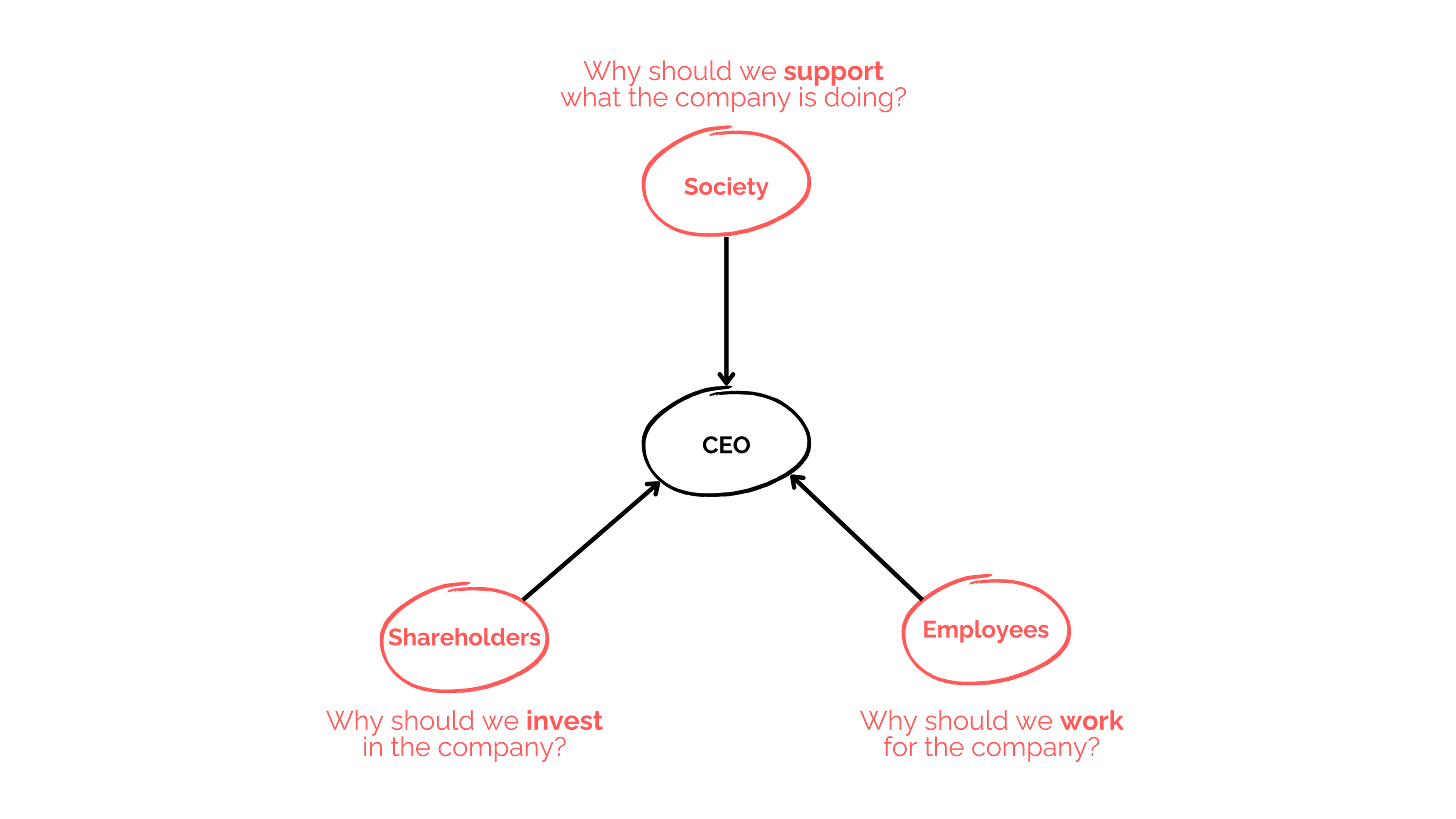CEO Stories
The different types of stories CEOs need to create and the teams that help create them
In my letter a few weeks back, I wrote how a company is nothing but a story and how its leaders, especially the CEO, are hired to create and sell the company’s story to various stakeholders.
I also wrote how in a big, mature, and complex organization, the CEO and other leaders need partners, such as Strategy and Finance, to create and communicate a realistic and credible yet compelling and inspiring story to the various stakeholders in and around the company.
In this post I want to develop that thought further: to reflect not only on the different types of stories that leaders such as CEOs need to create and communicate but also the teams within their organization which they rely on to create and communicate these stories and the audience for each of these stories.
The Three Key Stakeholders
For any company there are three big stakeholders who want to know why they should associate/engage/partner with the company. These are:
The Society, consisting of the broader public, government agencies, regulatory authorities, and partners from whom the company requires support.
The Shareholders, made up of the board and the investors from whom the company needs capital.
The Employees, made up of various teams such as product, sales, marketing, operations, and support from whom the company needs their time and effort.
Each of these stakeholders is important for the company because their support, capital, time is essential in helping the company develop and distribute its product in the real world.
The Three Big Questions
Accordingly there are three big questions these stakeholders ask the company:
The Broader Society wants to know why it should support what the company is doing?
The Shareholders want to know why they should invest in the company?
The Employees want to know why they should work for the company?
The answers to each of these questions, essentially communicated by the CEO in the form of stories, are crucial in ensuring that the company successfully communicates a compelling vision which allows it to to gather the necessary resources (capital, labour) and support to build and distribute its product.
Building Stories that Answer the Questions
It is important to realize here that the process of creating stories which answer these questions is not one-directional. It is not one-directional because each of these stakeholders has a say in and wants to exert influence on the final story the company creates about its future.
Despite popular perceptions, the CEO cannot and does not create these stories and communicate them unilaterally to the stakeholders. Instead, what happens is a dialectical process whereby through a process of dialogue between the CEO and the stakeholders the questions become clearer and their answers are negotiated.
For each stakeholder there are essentially four steps which need to undertaken to make sure that the questions are understood and answered:
✅ Understand and Prioritize the top concerns/questions on each stakeholder’s mind.
🤝 Liaise and Negotiate with the shareholder on possible answers which incorporate inputs from the CEO.
✍️ Create and Craft the story which answers the stakeholders’ questions in a format, mode, and method specific to them.
📣 Communicate and Sell the story to the stakeholders through the various forums
Executing this process well is essential in making sure that the company understands the demands of each stakeholder and, in creating the story of the company, ensures that they are considered and incorporated as relevant and required.
The Three Storytellers which help CEOs build Stories
This is why, given the importance of these stories, and the complexity in answering them (the four-step process), each company has a dedicated team to make sure that the process of creating, crafting, and communicating the company’s story to the relevant stakeholder is taken care of. Accordingly the three teams in each company are:
The PR Team, which is essentially responsible for liaising and communicating with the broader society to understand and prioritize its questions regarding the company’s vision, direction, and objectives.
The Finance Team, which is responsible for liaising and communicating with the company’s investors, shareholders, and the board to understand and prioritize their questions regarding the company’s current performance, future plans, and projected financial returns.
The Strategy Team, which is responsible for liaising with and communicating with the company’s employees to understand and prioritize their questions regarding the company’s vision, objectives, goals, culture and compensation philosophy.
Not only do these teams liaise, communicate, and negotiate with these stakeholders they also make sure that the story being told to them is in the language that they are used to:
In case of the Broader Society this means the PR team using compelling and memorable slogans to communicate the company’s vision and priorities through the mediums of the company’s website, press releases, media articles, trade shows, and leadership interviews.
In case of Shareholders this means the Finance team using financial models to communicate hard numbers on current performance, future plans, and financial returns through various forums such as Monthly board reviews, Quarterly analyst calls and Annual shareholders meetings.
In case of Employees this means the Strategy team using OKRs to communicate the company’s short, mid, long term strategy communicated through various forums such as Weekly Town Halls, Monthly Business Reviews, Quarterly Leadership Meetings, Annual Retreats etc.
With each team helping the CEO feel out the concerns of the relevant stakeholders and help liaise and negotiate the outcome, the CEO is able to get a better sense of the limitations that they are working with, the strategy that makes the most sense within those limitations, and the compromises that they need to make to bring it into reality.
At the same time, with each team working with the relevant stakeholders to hear their concerns and, where appropriate, to have them incorporated into the final story for the company, the stakeholders feel heard and are more engaged and more willing to provide their support, capital or time in helping the company achieve its goals.
The value that these teams bring to the CEO cannot be understated. Without them the CEO is unable to make sense of the most important issues and the trade-offs that need to be made to solve them. In effect, these teams help the CEO create a space for the company in the real world and set it up for success.
A company where the CEO is supported by strong Strategy, Finance and PR teams is likely to have a compelling, inspiring, credible, and realistic story which helps galvanize the stakeholders around the company. Conversely, where either of the teams is not working the CEO and the company is likely to find it a struggle to find its place in society.
Closing Thoughts
Before signing off I would like to add a few comments and caveats:
The word ‘stories’ sometimes gives the sense to the reader that what is being communicated is likely not real, that it is a fiction, and in the worst case possibly a lie. However that is not the sense in which I use the word here. It goes without saying that the stories created and told by the CEO need to be grounded-in and built-on data and facts about the company’s past performance. But it also goes without saying that what the CEO is communicating is in fact a story about the future, albeit a credible and realistic one.
To those familiar with working in big companies it is probably obvious that the stories discussed here are typically created as part of the company’s annual planning cycle in which the three teams discussed here, Strategy, Finance and PR, play a key role. The challenges, difficulties and nuances in running a successful cycle are maybe a topic for another day.
It is also worth stating that while I have separated the roles of the Finance and Strategy teams in exclusively helping the CEO manage the Shareholders and Employees respectively, the reality is a little bit more nuanced in that both teams will overlap in managing these stakeholders.
Further Explorations
I would love to hear what you guys think about this topic. Have any of you worked in or worked with the teams discussed here? How has your experience been? Personally I have worked much more closer with the Finance and Strategy functions in my career so for those in the PR function I would love to hear more from you
I would also love to hear how useful you found this topic. Are there similar topics you are interested in? What would you want to hear about next?
As usual, I would like to end this edition with some resources I came across while structuring my thoughts for this article and which you can use to further explore this and adjacent topics:
Resources for CEOs: There are many articles on HBR which talk about what CEOs and Leaders need to be successful but Seven Surprises for New CEOs is likely the one which resonates most closely with the topics discussed here. The article highlights the key challenges/surprises faced by a new CEO such as finding out what is really going on while being far from the business; managing priorities of different stakeholders; and trying to exert influence while realizing you are not the boss. While the article does not specifically talk about the role of the Strategy, Finance, and PR teams, the challenges the article discusses are essentially what these team work on to support the CEO.
Resources for Strategy Professionals: Your Strategy Needs a Story is an article I liked as well and it emphasizes why it is important for a strategy to not only be analytically sound but also effectively communicated through stories that resonate with stakeholders in order to bridge the gap between strategic planning and actionable results.
Resources for Finance Professionals: CFO Insights What's your story? is a nice mini-resource which talks about the importance of storytelling for CFOs and tips and how they can go about doing it. Andy Raskin, an ex-founder and marketeer who helps C-suite leaders to craft strategic narratives, has a nice podcast discussion on Building the Storytelling Muscle for CFOs which is quite insightful as well.






